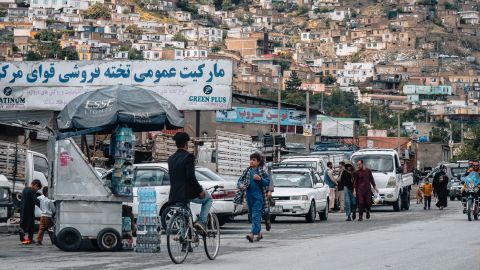CNN
—
Most of the time, headlines about Afghanistan are ringed with tragedy: food shortages, orphaned children, and even executions.
Since the Taliban took full control of the country in 2021, the humanitarian situation there has deteriorated, as economic and diplomatic isolation does little to alleviate strife caused by human rights abuses perpetrated by the country’s new rulers.
Yet daily life goes on.
Now experiencing their first significant pause in conflict for decades, Kabul and other towns continue to bustle with commerce. Shops and restaurants are still open. Battered autos throng the roads. Electricity is in short supply, but generators keep lights on in hotels and the homes of those who can afford them.
And while many outsiders might be under the impression that Afghanistan is sealed off, that isn’t entirely the case. Its airports and border crossings are open – and despite advice from multiple governments to avoid the country, some bold travelers are making trips to see what it’s like.
For travel vlogger Kristijan Iličić, the opportunity to be a tourist in Afghanistan was too interesting to turn down.
He’d visited the country in 2020 and had remained in touch with some of the people he met there, but the departure of American forces and the return to Taliban rule in 2021 made him curious about what had changed since his initial trip.
“I wanted to see how some of my friends are coping now under Taliban rule,” Iličić told CNN.
The reality is that many aren’t coping.
The United Nations estimates that some 22 million people – around half the population – need urgent food aid after the worst winter in 15 years. The Taliban has all but erased women from public life, recently banning them from working in non-governmental organizations (NGOs), which has limited help in some places.
Arash Azizzada, co-director of the nonprofit Afghans For A Better Tomorrow, says while travelers may be curious about the country, their presence could serve the interests of the Taliban more than the people.
“The Taliban regime is a pariah around the globe and desperate for any kind of positive media or positive portrayal of what is a brutal and disastrous reign,” says Azizzada, who is Afghan American.
He believes that foreign vloggers and influencers who go to Afghanistan under the current regime are participating in “atrocity tourism.”
“At best, these travel vloggers who visit Afghanistan are clueless and naive,” says Azizzada. “At worst, they are useful idiots whose opportunism helps whitewash the Taliban’s awful crimes.”
For those intent on going, the biggest hub for international flights in and out of Afghanistan is the United Arab Emirates: There are 16 flights a week to Kabul International Airport from Dubai and another three from Abu Dhabi.
Beyond that, there are direct flights from Istanbul, Turkey, as well as from the Pakistani capital of Islamabad and from Jeddah, Saudi Arabia. Land borders with Uzbekistan, Iran and Tajikistan are also open.
However, travelers can’t simply turn up at the airport and get on a plane. Citizens of most Western countries need a tourist visa and there are fewer Afghan embassies around the world than there were two years ago.
Iličić, who is Croatian, said he was able to obtain a visa within 24 hours at a cost of $500 at the Afghan embassy in Dubai.
And there’s more to consider than just getting a visa. While the Taliban have brought relative peace to Afghanistan, there are still security issues, with regular attacks claimed by the terror group ISIS.
As international sanctions bite, famine, collapsing healthcare and worsening sanitation bring their own consequences, as do the frequent natural disasters that blight the country.

Travelers who do choose to go to Afghanistan may not be supported by their home country if something goes wrong or they need help.
The United States closed its Kabul embassy in August 2021 and a Level Four: Do Not Travel tourism advisory remains in place.
A notice from the State Department reads: “Travel to all areas of Afghanistan is unsafe and the risk of kidnapping or violence against US citizens in Afghanistan is high. The US government is not able to provide emergency citizen services in Afghanistan and our ability to assist detained US citizens is extremely limited.”
The United Kingdom also strongly advises its citizens not to travel there.
For a traveler who is determined to go to Afghanistan, travel insurance is available but may have caveats or higher costs.
“The vast majority of travel insurance policies sold will not provide cover and the policy is void or not in place if you go to a country that is on a government ‘Do Not Travel’ status,” Andrew Jernigan, CEO of travel insurance company Insured Nomads, tells CNN.
In situations like these, Insured Nomads offers a “World Explorer Hotspot” plan that begins at $810 per individual for one week. The plan includes what the company describes as “special ops and crisis response 24/7” and “kidnap and ransom services.”
So what is it actually like to visit now?
James Willcox, co-founder of tourism company Untamed Borders, has been leading groups to Afghanistan since 2008. He made his first trip under the Taliban’s new rule in fall 2022.
“Generally speaking, the country feels and is just a lot safer since I’ve ever worked there,” says Willcox.
Although that may seem puzzling for outsiders who have seen images of strife on TV, Willcox says that “as far as security is concerned in Afghanistan, the major anti-government group is now the government.”
In addition, the regime change had the unintended side effect of making certain parts of the country more accessible for visitors.
As a result, he and his clients have been able to visit more parts of the country than they could before, namely one-time Taliban bastion Kandahar in southern Afghanistan.
The Untamed Borders group stayed in a range of accommodation during their visit: hotels in larger cities, homestays in rural areas and even one night camping in pop-up tents in the Bamiyan valley, most famous for the colossal Buddha statues that were destroyed by the previous Taliban government in 2001.
While there were restaurants and cafes open in Kabul and other cities, the group ate dinner at their homestays to avoid venturing out at night in rural regions.
Willcox also had the group travel around in regular cars instead of SUVs or tricked-out Jeeps. “About 95{6932ee47e64f4ce8eedbbd5224581f6531cba18a35225771c06e4f1b3f0d9667}” of cars in Afghanistan are Toyotas, specifically models like Corollas and Camrys, so he knew his clients would attract less attention using the same kinds of vehicles.
Iličić and the driver and translator he hired stayed in small, locally owned hotels and homestays. He says he loved one of the Afghan national dishes, kabuli pilaw, a lamb and rice pilaf, and ate it “every day,” while also sampling kebabs and street food in Kabul last fall.

On making their return visits, both Willcox and Iličić were able to visit new regions of the country, and both crossed off a bucket list item by going to the Minaret of Jam, a 12th-century structure in remote Ghor province that was the country’s first UNESCO World Heritage site.
Still, there were last-minute wrinkles. It’s customary in rural areas to request permission to visit from the local leadership, which was tricky on Fridays when everything is closed for the Muslim day of worship.
Willcox says security checkpoints remain an ongoing reality of life in Afghanistan, though now they’re manned by Taliban fighters rather than foreign military personnel or the Afghan National Army.
“Obviously nothing’s been rebuilt (because) there’s no money. There’s Taliban flags around, but apart from that, everything looks pretty much the same,” says Willcox. “And at the checkpoints one of the most remarkable things is the Taliban fighters had zero interest in us.”
Iličić feels that the Taliban were interested in his vlogging and saw it as an opportunity to get good PR. At a checkpoint in Bamiyan, he says, he was invited in for tea and a chat.
“The Taliban wanted to represent themselves as peaceful people (so) they let me go to all the destinations I was planning to go. The Taliban from 20 years ago didn’t care what the world thought of them. This version, Taliban 2.0, does care. They are trying to send a good image of them into the world.”
There’s a reason that Iličić, who often travels with his wife Andrea, visited Afghanistan solo.
The Taliban has increasingly limited the public sphere of women since taking power, restricting them from workplaces, educational institutions and even public parks.
Unsurprisingly, clothing – specifically head coverings – are a common question for the prospective tourists who contact Untamed Borders.
“It’s up to the guide to make sure that our female tourists are respectable,” says Willcox, the tour leader. “The guys are responsible for upholding certain values and if they don’t, they’re shamed.”
Willcox and his colleagues bring along appropriate clothing for both male and female travelers to wear. Because of local laws requiring women to have a male chaperone, they ask female guests not to leave their guesthouses by themselves.
However, Willcox says, in some ways women have different kinds of freedoms as tourists in Afghanistan. They can mix freely and chat with local women about their day-to-day life in the country.
Any trip has its pros and cons, but those who have been there say visiting Afghanistan is still something for only the most daring travelers.
“Although Afghanistan is not the most dangerous country in the world, it is still not safe,” says Iličić. “My advice is: do thorough research, get a very good local guide, respect the culture which you are visiting, be kind to people (and) follow the rules.




More Stories
Maximizing Your Savings – Expert Strategies For Travel Discounts
Unlocking Growth: 15 Strategies for Boosting Leads and Customers for Your North Georgia Business
Indonesia Travel Advice & Safety